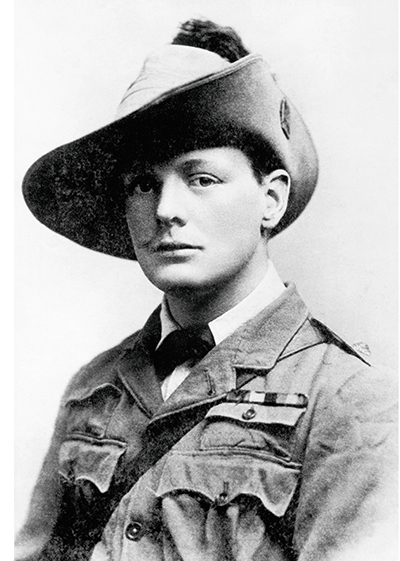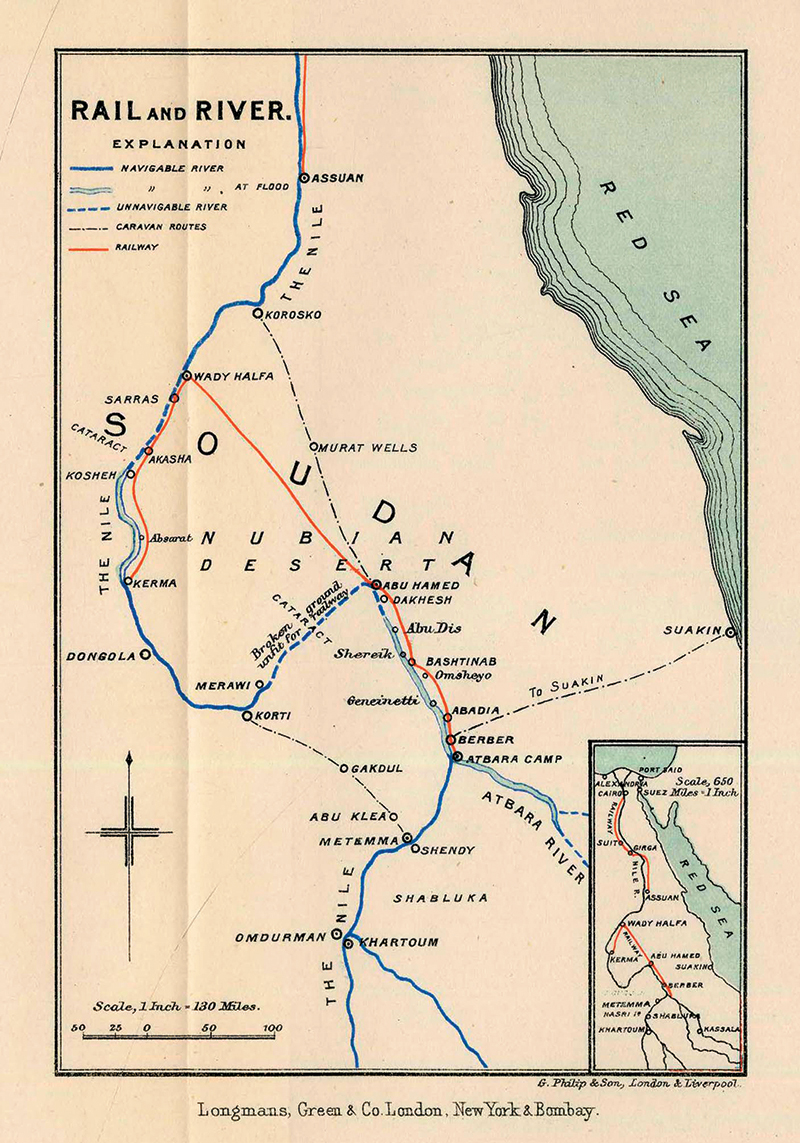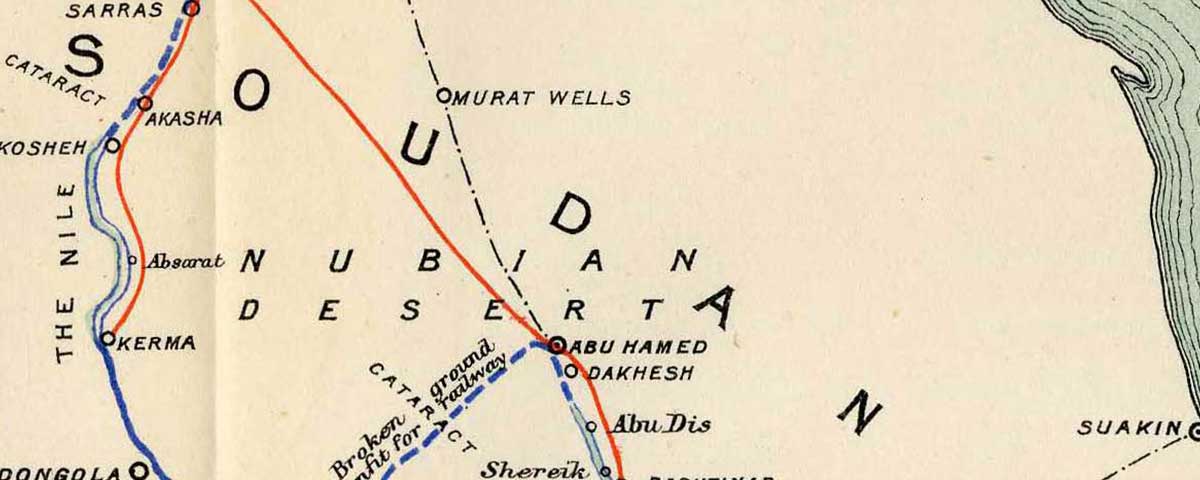In 1898 Winston Churchill was a young lieutenant with the 21st Lancers, riding south with General Herbert Horatio Kitchener’s army to reclaim Sudan from the Mahdist forces that had controlled it for more than a decade. Kitchener had tried to thwart Churchill’s posting, having heard of his reputation as an upstart and war correspondent, but luck—and Churchill’s connections—had prevailed.
As the expeditionary force followed the Nile south upriver, Churchill filed anonymous but vivid accounts of its progress with the Morning Post. He was at the decisive September 2 battle for the Mahdist capital of Omdurman, when the Dervish army, though vastly outnumbering Kitchener’s Anglo-Egyptian-Sudanese force, moved “forward in the face of the pitiless fire” of Maxim guns, artillery, and rifles. The following year the 24-year-old Churchill resigned from the army and published his two-volume River War, describing the campaign and the “Soudan of the soldier….its squalid villages….its ample deserts…its hot, black rocks.”
Below is an excerpt from chapter 9, detailing the fighting at the village of Abu Hamed in early August and the continued struggle to move gunboats up the Nile toward Omdurman.
THE VILLAGE OF ABU HAMED straggles along the bank of the Nile, and consists of a central mass of mud houses, intersected by a network of winding lanes and alleys, about 500 yards long by perhaps 100 yards wide. To the north and south are detached clusters of ruined huts, and to the south there rises a large, ragged pile of rocks. The ground slopes gradually up from the river, so that at a distance of 300 yards the village is surrounded on three sides by a low plateau. Upon this plateau stand three stone watch-towers, which were erected by General Gordon [Charles “Chinese” Gordon, who had died in the defense of Khartoum in 1885]. The Dervish garrison were strongly posted in shelter trenches and loop-holed houses along the eastern face of the village. The towers were held by their outposts.
 Making a wide circuit to their left, and then swinging round to the right, so as to front facing the river, the brigade silently moved towards the enemy’s position, and at a quarter past six occupied the plateau in a crescent-shaped formation; the XIth Soudanese on the right, opposite the north-east corner of the village; the battery, escorted by the remaining half-battalion of the 3rd Egyptians, next; then the IXth in the centre, and the Xth Soudanese on the left flank. As the troops approached the watch-towers the Dervish outposts fell back and the force continued to advance until the edge of the plateau was reached. From here the whole scene was visible.
Making a wide circuit to their left, and then swinging round to the right, so as to front facing the river, the brigade silently moved towards the enemy’s position, and at a quarter past six occupied the plateau in a crescent-shaped formation; the XIth Soudanese on the right, opposite the north-east corner of the village; the battery, escorted by the remaining half-battalion of the 3rd Egyptians, next; then the IXth in the centre, and the Xth Soudanese on the left flank. As the troops approached the watch-towers the Dervish outposts fell back and the force continued to advance until the edge of the plateau was reached. From here the whole scene was visible.
The day was just breaking, and the mist hung low and white over the steel-grey surface of the river. The outlines of the mud houses were sharply defined on this pale background. The Dervish riflemen crouched in the shelter trench that ran round the village. Their cavalry, perhaps a hundred strong, were falling in hurriedly on the sandy ground to the south near the ragged rocks. The curve of the hills, crowned with the dark line of the troops, completed and framed the picture. Within this small amphitheatre one of the minor dramas of war was now to be enacted.
At half past six the battery came into action, and after a few shells had been fired at the loop-holed houses in the left centre of the position, a general advance was ordered. In excellent order the three Soudanese battalions, with General Hunter, Lieutenant Colonel MacDonald, and the other British officers on horseback in front of their line, advanced slowly down the hill, opening a destructive fire on the entrenchment. The distance was scarcely 300 yards; but the crescent formation of the attack made the lines of advance converge, and before half the distance was covered the Xth were compelled to halt, lest the XIth Soudanese on the right flank should fire into them. The Dervishes remained silent until the troops were within a hundred yards, when they discharged two tremendous volleys, which were chiefly effective upon the halted battalion. Major Sidney, Lieutenant Fitzclarence, and a dozen men were shot dead. More than 50 men were wounded. All the Soudanese thereupon with a loud shout rushed upon the entrenchment, stormed it, and hunted the Dervishes into the houses. In the street-fighting which followed, the numbers of the troops prevailed. The advance scarcely paused until the river bank was reached, and by 7:30 Abu Hamed was in the possession of the Egyptian forces.
The Dervish horsemen, who had remained spectators near the southern crag during the attack, fled towards Berber [a Mahdist stronghold 120 miles south] as soon as they saw the attack successful. Scarcely any of the infantry escaped.
In this action, besides the two British officers, Major H. M. Sidney and Lieutenant E. Fitzclarence, 21 native soldiers were killed; 61 native soldiers were wounded.
The news of the capture of Abu Hamed was carried swiftly by camel and wire to all whom it might concern. The Sirdar [General Kitchener], anticipating the result, had already ordered the gunboats to commence the passage of the Fourth Cataract. The camp at Railhead sprang to life after an unaccustomed rest, and the line began again to grow rapidly. The Dervishes who were hurrying from Berber were only 20 miles from Abu Hamed when they met the fugitives. They immediately turned back, and retired to the foot of the Fifth Cataract, whence after a few days’ halt they continued their retreat. Their proximity to the captured village shows how little time the column had to spare, and that General Hunter was wise to press his marches. The Emir who commanded at Berber heard of the loss of the outpost on the 9th. He sent the messenger on to Metemma. Mahmud replied on the 11th that he was starting at once with his whole army to reinforce Berber. Apparently, however, he did not dare to move without the Khalifa’s permission; for his letters, as late as the 20th, show that he had not broken his camp, and was still asking the Emir for information as to the doings of the “Turks.” Of a truth there was plenty to tell.
ON THE 4TH OF AUGUST the gunboats El Teb and Tamai [had] approached the Fourth Cataract to ascend to the Abu Hamed–Berber reach of the river. Major David was in charge of the operation. Lieutenants Hood and Beatty (Royal Navy) commanded the vessels. Two hundred men of the 7th Egyptians were towed in barges to assist in hauling the steamers in the difficult places. The current was, however, too strong, and it was found necessary to leave three barges, containing 160 soldiers, at the foot of the rapids. Nevertheless, as the cataract was not considered a very formidable barrier, Major David determined to make the attempt. Early on the 5th, therefore, the Tamai tried the ascent. About 300 local Shaiggia tribesmen had been collected, and their efforts were directed—or, as the result proved, mis-directed—by those few of the Egyptian soldiers who had not been left behind. The steamer, with her engines working at full speed, succeeded in mounting half the distance. But the rush of water was then so great that her bows were swept round, and, after a narrow escape of capsizing, she was carried swiftly down the stream.
The officers thought that this failure was due to the accidental fouling of a rope at a critical moment, and to the fact that there were not enough local tribesmen pulling at the hawsers. Four hundred more Shaiggia were therefore collected from the neighbouring villages, and in the afternoon the Teb attempted the passage. Her fortunes were far worse than those of the Tamai. Owing to the lack of co-operation and discipline among the local tribesmen, their utter ignorance of what was required of them, and the want of proper supervision, the hauling power was again too weak. Again the bows of the steamer were swept round, and, as the hawsers held, a great rush of water poured over the bulwarks. In 10 seconds the Teb heeled over and turned bottom upwards. The hawsers parted under this new strain, and she was swept down stream with only her keel showing. Lieutenant Beatty and most of the crew were thrown, or glad to jump, into the foaming water of the cataract, and, being carried down the river, were picked up below the rapids by the Tamai, which was luckily under steam. Their escape was extraordinary, for of the score who were flung into the water only one Egyptian was drowned. Two other men were, however, missing, and their fate seemed certain. The capsized steamer, swirled along by the current, was jammed about a mile below the cataract between two rocks, where she became a total wreck. Anxious to see if there was any chance of raising her, the officers proceeded in the Tamai to the scene. The bottom of the vessel was just visible above the surface. It was evident to all that her salvage would be a work of months. The officers were about to leave the wreck, when suddenly a knocking was heard within the hull. Tools were brought, a plate was removed, and there emerged, safe and sound from the hold in which they had been thus terribly imprisoned, the second engineer and a stoker. When the rapidity with which the steamer turned upside down, with the engines working, the fires burning, and the boilers full—the darkness, with all the floors become ceilings—the violent inrush of water—the wild career down the stream—are remembered, it will be conceded that the experience of these men was sufficiently remarkable.
Search was now made for another passage. This was found on the 6th, nearer the right bank of the river. On the 8th the Metemma arrived with 300 more men of the 7th Egyptians. Three days were spent in preparations and to allow the Nile to rise a little more. On the 13th, elaborate precautions being observed, the Metemma passed the cataract safely, and was tied up to the bank on the higher reach. The Tamai followed the next day. On the 19th and 20th the new gunboats Fateh, Naser, and Zafir, the most powerful vessels on the river, accomplished the passage. Meanwhile the Metemma and Tamai had already proceeded up stream. On the 23rd the unarmed steamer Dal made the ascent, and by the 29th the whole flotilla reached Abu Hamed safely.
AFTER THE ARRIVAL OF THE GUNBOATS, events began to move at the double. The sudden dart upon Abu Hamed had caused the utmost consternation among the Dervishes. Finding that Mahmud was not going to reinforce him, and fearing the treachery of the local tribes, Zeki Osman, the Emir in Berber, decided to fall back, and on the 24th he evacuated Berber and marched south. On the 27th General Hunter at Abu Hamed heard that the Dervish garrison had left the town. The next day he despatched Abdel-Azim, the chief of Irregulars, and Ahmed Bey Khalifa, his brother, with 40 Ababda tribesmen, to reconnoitre. These bold fellows pushed on recklessly, and found the inhabitants everywhere terrified or acquiescent. Spreading extraordinary tales of the strength of the army who were following them, they created a panic all along the river, and, in spite of a sharp fight with a Dervish patrol, reached Berber on the 31st. As there was no armed force in the town, the enterprising allies rode into the streets and occupied the grain store—the only public building—in the name of the Government. They then sent word back to Abu Hamed of what they had done, and sat down in the town, thus audaciously captured, to await developments.
The astonishing news of the fall of Berber reached General Hunter on the 2nd of September. He immediately telegraphed to Merawi. Sir Herbert Kitchener was confronted with a momentous question: Should Berber be occupied or not? It may at first seem that there could be little doubt about the matter. The objective of the expedition was Omdurman. The occupation of Berber by an Egyptian garrison would settle at once the difficulties near Suakin. The town was believed to be on the clear waterway to the Dervish capital [Omdurman]. The moral effect of its capture upon the riverain tribes and throughout the Soudan would be enormous. Berber was, in fact, the most important strategic point on the whole line of advance. This great prize and advantage was now to be had for the asking.





